Howard Andrew Jones's Blog, page 46
April 24, 2015
Swords Against Death Re-Read: “The Sunken Land”
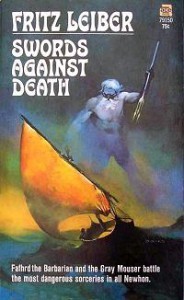 Bill Ward and I are re-reading a book from Fritz Leiber’s famous Lankhmar series, Swords Against Death. We hope you’ll pick up a copy and join us. This week we tackled the sixth tale in the volume, “The Sunken Land.”
Bill Ward and I are re-reading a book from Fritz Leiber’s famous Lankhmar series, Swords Against Death. We hope you’ll pick up a copy and join us. This week we tackled the sixth tale in the volume, “The Sunken Land.”
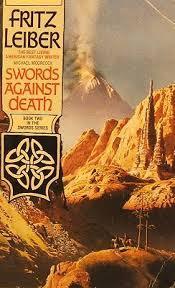 Howard: This is a grand tale, told with economy. Heck, that sentence could practically stand as my review, but I’ll get more specific. Like “The Howling Tower,” this tales feels as if it were written to a definite word count limit, but this time there’s exactly enough room to say what needs to be said. As a matter of fact, it’s just about perfect. Last week we saw a tale that was mostly about the Mouser on his own — this week we read one that was mostly Fafhrd on his own. And what a story! Opening with that fantastic scene where Fafhrd shouts that he was born with luck as a twin, it blazes forward and never looks back.
Howard: This is a grand tale, told with economy. Heck, that sentence could practically stand as my review, but I’ll get more specific. Like “The Howling Tower,” this tales feels as if it were written to a definite word count limit, but this time there’s exactly enough room to say what needs to be said. As a matter of fact, it’s just about perfect. Last week we saw a tale that was mostly about the Mouser on his own — this week we read one that was mostly Fafhrd on his own. And what a story! Opening with that fantastic scene where Fafhrd shouts that he was born with luck as a twin, it blazes forward and never looks back.
Bill: That articulates what I was thinking, that it feels like a similar kind of story to last week’s, a weird tale. Even though the central character changes, notice both times it’s the Mouser who has to go get his big friend, that twin of luck, out of trouble again.
Howard: Good point. I’m trying to recall if that’s a regular aspect of their relation or not. The prose swept me along so easily that I had to force myself to stop and pay attention to the scaffolding. Studying this piece in detail is like taking an entire course on writing. How about the wonderful opening, and then the way description is worked in as the story moves along, as if Leiber’s a skilled cameraman? How many modern writers can do that? (For that matter, how many writers of Leiber’s time could do that?) Then there’s the “coincidence” of the ring and the northerner’s long ship that turns out not to be; the Mingol who provides just enough information and then gets killed when his purpose in the story has been served, his death serving to emphasize ANOTHER purpose. How about all the excellent mood setting descriptions? And how about the loyal steersman, ready to stand up for Fafhrd more than once because they fought the waves together? These are all nice little touches that add to the story’s success — although none of them would have carried the tale if the tale itself hadn’t been rock solid.
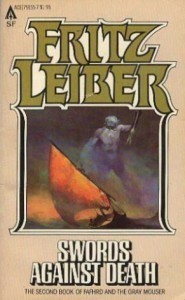 Bill: Leiber really is something, isn’t he? I want to go back and read certain lines sometimes, but I’m usually swept up, as you say.
Bill: Leiber really is something, isn’t he? I want to go back and read certain lines sometimes, but I’m usually swept up, as you say.
Howard: Let’s not forget the horror, a sometimes overlooked ingredient in sword-and-sorcery. As you mentioned last week, Leiber’s really skilled with horror and descriptions of the supernatural. I suppose in a lot of ways this short story is far more horror than a sword-and-sorcery romp. I mean, Fafhrd does wield his sword, but not against the THINGS. That would have been folly.
Do you remember how I worried how I’d feel about this book, coming back to it after twenty-five years? Well, I applaud my taste as a young man. This collection is chock full of great writing. It’s no wonder I fell in love with these stories and that they had such a lasting impact upon me.
Bill: Good taste indeed. There’s a reason people still love these stories after so many decades. The description of what horrors awaited the crew at the end were also drawn with the same economy and subtlety as the weird menaces from last week. The sea descriptions and the boat business — all of it, really — were written with a very confident and knowing hand. There is a paragraph at the end that covers Fafhrd’s flight that is a jewel of concise, fast-paced, colorful writing.
Also, on an unrelated note, it occurred to me while reading this story that it was the direct inspiration for a story I wrote years ago, but I had utterly forgotten that until reading it again this time around.
Howard: I’m not surprised! There are so many good ideas and approaches in here. I’ve tried to start tales with dialogue that launch as well as this, but I’ve yet to manage it.
On another note, I’ve always believed that the painted image of the ship used on my favorite version of the cover (by Jeff Jones, with the sea god on the right hand side) was an image from this particular story. The ship lacks a pontoon, but perhaps its just not noticeable because it’s under a wave. (On the other hand, supposedly Fafhrd rigged the ship with a triangular sail, and it’s not completely clear to me what the sail’s shape is.)
Anyway, next week we’re looking at “The Seven Black Priests.” Hope to see you here!
Swords Against Death Re-Read: The Sunken Land
 Bill Ward and I are re-reading a book from Fritz Leiber’s famous Lankhmar series, Swords Against Death. We hope you’ll pick up a copy and join us. This week we tackled the sixth tale in the volume, “The Sunken Land.”
Bill Ward and I are re-reading a book from Fritz Leiber’s famous Lankhmar series, Swords Against Death. We hope you’ll pick up a copy and join us. This week we tackled the sixth tale in the volume, “The Sunken Land.”
 Howard: This is a grand tale, told with economy. Heck, that sentence could practically stand as my review, but I’ll get more specific. Like “The Howling Tower,” this tales feels like it was written to a definite word count limit, but this time there’s exactly enough room to say what needs to be said. As a matter of fact, it’s just about perfect. Last week we saw a tale that was mostly about the Mouser on his own — this week we read one that was mostly Fafhrd on his own. And what a story! Opening with that fantastic scene where Fafhrd shouts that he was born with luck as a twin, it blazes forward and never looks back.
Howard: This is a grand tale, told with economy. Heck, that sentence could practically stand as my review, but I’ll get more specific. Like “The Howling Tower,” this tales feels like it was written to a definite word count limit, but this time there’s exactly enough room to say what needs to be said. As a matter of fact, it’s just about perfect. Last week we saw a tale that was mostly about the Mouser on his own — this week we read one that was mostly Fafhrd on his own. And what a story! Opening with that fantastic scene where Fafhrd shouts that he was born with luck as a twin, it blazes forward and never looks back.
Bill: That articulates what I was thinking, that it feels like a similar kind of story to last week’s, a weird tale. Even though the central character changes, notice both times it’s the Mouser who has to go get his big friend, that twin of luck, out of trouble again.
Howard: Good point. I’m trying to recall if that’s a regular aspect of their relation or not. The prose swept me along so easily that I had to force myself to stop and pay attention to the scaffolding. Studying this piece in detail is like taking an entire course on writing. How about the wonderful opening, and then the way description is worked in as the story moves along, as if Leiber’s a skilled cameraman? How many modern writers can do that? (For that matter, how many writers of Leiber’s time could do that?) Then there’s the “coincidence” of the ring and the northerner’s long ship that turns out not to be; the Mingol who provides just enough information and then gets killed when his purpose in the story has been served, his death serving to emphasize ANOTHER purpose. How about all the excellent mood setting descriptions? And how about the loyal steersman, ready to stand up for Fafhrd more than once because they fought the waves together? These are all nice little touches that add to the story’s success — although none of them would have carried the tale if the tale itself hadn’t been rock solid.
 Bill: Leiber really is something, isn’t he? I want to go back and read certain lines sometimes, but I’m usually swept up, as you say.
Bill: Leiber really is something, isn’t he? I want to go back and read certain lines sometimes, but I’m usually swept up, as you say.
Howard: Let’s not forget the horror, a sometimes overlooked ingredient in sword-and-sorcery. As you mentioned last week, Leiber’s really skilled with horror and descriptions of the supernatural. I suppose in a lot of ways this short story is far more horror than a sword-and-sorcery romp. I mean, Fafhrd does wield his sword, but not against the THINGS. That would have been folly.
Do you remember how I worried how I’d feel about this book, coming back to it after twenty-five years? Well, I applaud my taste as a young man. This collection is chock full of great writing. It’s no wonder I fell in love with these stories and that they had such a lasting impact upon me.
Bill: Good taste indeed. There’s a reason people still love these stories after so many decades. The description of what horrors awaited the crew at the end were also drawn with the same economy and subtlety as the weird menaces from last week. The sea descriptions and the boat business — all of it, really — were written with a very confident and knowing hand. There is a paragraph at the end that covers Fafhrd’s flight that is a jewel of concise, fast-paced, colorful writing.
Also, on an unrelated note, it occurred to me while reading this story that it was the direct inspiration for a story I wrote years ago, but I had utterly forgotten that until reading it again this time around.
Howard: I’m not surprised! There are so many good ideas and approaches in here. I’ve tried to start tales with dialogue that launch as well as this, but I’ve yet to manage it.
On another note, I’ve always believed that the painted image of the ship used on my favorite version of the cover (by Jeff Jones, with the sea god on the right hand side) was an image from this particular story. The ship lacks a pontoon, but perhaps its just not noticeable because it’s under a wave. (On the other hand, supposedly Fafhrd rigged the ship with a triangular sail, and it’s not completely clear to me what the sail’s shape is.)
Anyway, next week we’re looking at “The Seven Black Priests.” Hope to see you here!
April 21, 2015
Return to The Desert of Souls
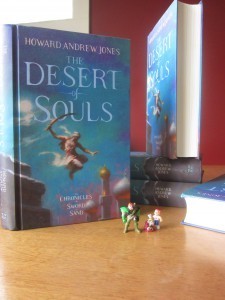 Every once in a while nice surprises float up from the ‘net. I just read an enthusiastic new review of The Desert of Souls from a mystery review site, and there’s discussion in the comments page wondering if there are to be more stories about Dabir and Asim.
Every once in a while nice surprises float up from the ‘net. I just read an enthusiastic new review of The Desert of Souls from a mystery review site, and there’s discussion in the comments page wondering if there are to be more stories about Dabir and Asim.
Well… Sooner or later there probably will be. Certainly my wife would love me to write more, because she likes Dabir and Asim more than any other characters I’ve ever used, even the ones I’m writing about now. At the least, I’ll one day write a third novel and resolve what happens between Dabir and the love of his life, from whom he was separated at the end of the first book. Maybe I’ll launch it as a Kickstarter or something.
Alas, the first book didn’t sell that well. The second, despite even stronger reviews, including a starred review from Publisher’s Weekly (and I was SURE that would guarantee good things for the series!) sold even more poorly. You can gauge this by dashing over to Amazon and comparing the number of reviews for each book.
I’ve stayed busy since creating a replacement series and writing Pathfinder novels. I didn’t PLAN on wandering in the wilderness for a while getting my act together, but that’s kind of what happened. I thought I had taken the news in stride and moved on to create new things, but watching that series tank really took the wind out of my sails. I love those characters, I love the Arabian Nights, I love the era — I spent years immersing myself in the time and culture. I spent years creating the characters and finding the right voice. I thought I’d found my calling, but I discovered, much like Crane’s man speaking to the universe, that the universe didn’t really care.
 On the plus side, I got two hardback books published (and more, if you count the short story e-book). Many writers don’t even get that chance, so I was lucky. And I’m very lucky to still be under contract for more. But then I’ve been fortunate with my book editors. Both Pete Wolverton from Thomas Dunne Books and James Sutter with the Pathfinder novel line are talented and supportive.
On the plus side, I got two hardback books published (and more, if you count the short story e-book). Many writers don’t even get that chance, so I was lucky. And I’m very lucky to still be under contract for more. But then I’ve been fortunate with my book editors. Both Pete Wolverton from Thomas Dunne Books and James Sutter with the Pathfinder novel line are talented and supportive.
The long and the short is that I’ll be writing new books for Pathfinder for a while to come (one’s due out in Fall and one’s coming out next Fall) and I hope to launch a new series through Thomas Dunne Books/St. Martin’s soon. The novel’s getting whipped back into shape since I stopped trying to write like anyone else and began writing like me again. And as for Dabir and Asim, when I get the chance I’ll write an occasional short story (as I did for last year’s Kaiju Rising anthology) and some day I’ll probably write at least one more book. I can’t see myself carrying out my original plan of drafting seven more Dabir and Asim novels unless the Kickstarter for the third and self-publishing turn out to be lucrative. My guess is that I’d have to have a wider following for that to happen.
As to why they didn’t succeed, I just can’t tell you. I wish I knew. I could tell you how often I paced and gnashed my teeth and all that, but that was distracting and pointless. I’ve finally let it go. Onward and upward.
Oh, and for that handful of you are wondering when I might launch a Dabir and Asim Kickstarter, it’s a ways down the road. I’ve got to edit a Pathfinder novel and write a couple of more books for my new series before there’s any kind of hole in my schedule. Watch this space.
April 16, 2015
Swords Against Death Re-Read: “The Howling Tower”
 Bill Ward and I are re-reading a book from Fritz Leiber’s famous Lankhmar series, Swords Against Death. We hope you’ll pick up a copy and join us. This week we tackled the fifth tale in the volume, “The Howling Tower.”
Bill Ward and I are re-reading a book from Fritz Leiber’s famous Lankhmar series, Swords Against Death. We hope you’ll pick up a copy and join us. This week we tackled the fifth tale in the volume, “The Howling Tower.”
Howard: In the overall run of Fafhrd and Gray Mouser episodes, this is a filler. That said, it’s a strong one, and holds up much better than, say “The Circle Curse” or even “The Bleak Shore” from last week. Having written to word count limits several times at this point, I couldn’t help feeling that’s what Leiber might have done here. He had a few thousand words worth of room to tell a story, so he kept it short and sweet. Or, possibly, he needed a quick check. Either way, what we got was fairly simple (though that doesn’t mean it wasn’t well executed). Consider the structure: 1. The setup, with the tower and the landscape and the howling. 2. Fafhrd’s disappearance and the Mouser’s pursuit. 3. The Mouser reaches the tower and the villain monologues. 4. The Mouser forces the villain into the nightmare realm with him. 5. The villain gets what’s coming to him.
Bill: I agree, I also noticed how concise the story was. The same basic elements could have gone into a longer story, one that culminated in an otherworldly combat with the spectral hounds, but instead it’s condensed right down into an effective little ghost story.
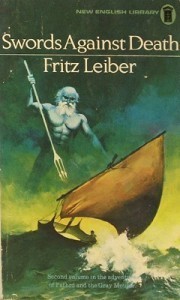 Howard: Right! It’s still pretty satisfying. Sure, it isn’t a great one like “Thieves’ House” or some of those coming up, but it fires on full cylinders all the way. The mystery and the danger are well presented, and I was actually afraid for Fafhrd, despite knowing he was going to come out okay. Leiber even makes the monologue work, which is a helluva thing. In lesser hands it would have been much more of an info dump. Leiber almost manages to make that rant completely about character even as the bad guy’s telling us everything we need to know about the setup.
Howard: Right! It’s still pretty satisfying. Sure, it isn’t a great one like “Thieves’ House” or some of those coming up, but it fires on full cylinders all the way. The mystery and the danger are well presented, and I was actually afraid for Fafhrd, despite knowing he was going to come out okay. Leiber even makes the monologue work, which is a helluva thing. In lesser hands it would have been much more of an info dump. Leiber almost manages to make that rant completely about character even as the bad guy’s telling us everything we need to know about the setup.
Bill: That struck me as well, learning so much about the villain — and I didn’t even spot it as set up for the end. The description of the killing of the hounds was vivid and chilling and really got my attention. Leiber is very good at that sort of thing.
Howard: He sure is. I didn’t see the scaffolding the first times I read this story — I was quite swept up by it. Now I can wonder how it was done, and under what constraints, and I see that Leiber didn’t have word space or inclination to spread out and deliver a more detailed story. But what he gave us works very well, thank you. I’m glad he gave us more, and pieces that were better developed, but this was enjoyable.
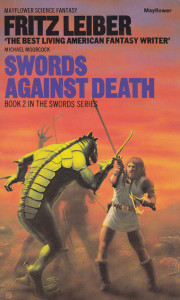 Bill: Short as it was he still had some time for some wonderful character moments — Fafhrd’s rather poetic invitation to “the wolves” to come share their fire, The Gray Mouser’s repulsion at having so terrified the old madman that he says he would have preferred simply killing him instead. The quick but none-the-less vivid details in the old man’s backstory also give a great explanation for a very common trope — this lone magician living in a haunted tower actually has a whole history leading up to that, all of which makes good sense. Even though it’s a quick story, it provides plenty of memorable images and moments.
Bill: Short as it was he still had some time for some wonderful character moments — Fafhrd’s rather poetic invitation to “the wolves” to come share their fire, The Gray Mouser’s repulsion at having so terrified the old madman that he says he would have preferred simply killing him instead. The quick but none-the-less vivid details in the old man’s backstory also give a great explanation for a very common trope — this lone magician living in a haunted tower actually has a whole history leading up to that, all of which makes good sense. Even though it’s a quick story, it provides plenty of memorable images and moments.
Howard: Next week we move on to one I re-read an awful lot, usually right before I’d read the story that follows it, which is a real favorite (“The Seven Black Priests”). On to “The Sunken Land.” Hope to see you here.
Swords Against Death Re-Read: The Howling Tower
 Bill Ward and I are re-reading a book from Fritz Leiber’s famous Lankhmar series, Swords Against Death. We hope you’ll pick up a copy and join us. This week we tackled the fifth tale in the volume, “The Howling Tower.”
Bill Ward and I are re-reading a book from Fritz Leiber’s famous Lankhmar series, Swords Against Death. We hope you’ll pick up a copy and join us. This week we tackled the fifth tale in the volume, “The Howling Tower.”
Howard: In the overall run of Fafhrd and Gray Mouser episodes, this is a filler. That said, it’s a strong one, and holds up much better than, say “The Circle Curse” or even “The Bleak Shore” from last week. Having written to word count limits several times at this point, I couldn’t help feeling that’s what Leiber might have done here. He had a few thousand words worth of room to tell a story, so he kept it short and sweet. Or, possibly, he needed a quick check. Either way, what we got was fairly simple (though that doesn’t mean it wasn’t well executed). Consider the structure: 1. The setup, with the tower and the landscape and the howling. 2. Fafhrd’s disappearance and the Mouser’s pursuit. 3. The Mouser reaches the tower and the villain monologues. 4. The Mouser forces the villain into the nightmare realm with him. 5. The villain gets what’s coming to him.
Bill: I agree, I also noticed how concise the story was. The same basic elements could have gone into a longer story, one that culminated in an otherworldly combat with the spectral hounds, but instead it’s condensed right down into an effective little ghost story.
 Howard: Right! It’s still pretty satisfying. Sure, it isn’t a great one like “Thieves’ House” or some of those coming up, but it fires on full cylinders all the way. The mystery and the danger are well presented, and I was actually afraid for Fafhrd, despite knowing he was going to come out okay. Leiber even makes the monologue work, which is a helluva thing. In lesser hands it would have been much more of an info dump. Leiber almost manages to make that rant completely about character even as the bad guy’s telling us everything we need to know about the setup.
Howard: Right! It’s still pretty satisfying. Sure, it isn’t a great one like “Thieves’ House” or some of those coming up, but it fires on full cylinders all the way. The mystery and the danger are well presented, and I was actually afraid for Fafhrd, despite knowing he was going to come out okay. Leiber even makes the monologue work, which is a helluva thing. In lesser hands it would have been much more of an info dump. Leiber almost manages to make that rant completely about character even as the bad guy’s telling us everything we need to know about the setup.
Bill: That struck me as well, learning so much about the villain — and I didn’t even spot it as set up for the end. The description of the killing of the hounds was vivid and chilling and really got my attention. Leiber is very good at that sort of thing.
Howard: He sure is. I didn’t see the scaffolding the first times I read this story — I was quite swept up by it. Now I can wonder how it was done, and under what constraints, and I see that Leiber didn’t have word space or inclination to spread out and deliver a more detailed story. But what he gave us works very well, thank you. I’m glad he gave us more, and pieces that were better developed, but this was enjoyable.
 Bill: Short as it was he still had some time for some wonderful character moments — Fafhrd’s rather poetic invitation to “the wolves” to come share their fire, The Gray Mouser’s repulsion at having so terrified the old madman that he says he would have preferred simply killing him instead. The quick but none-the-less vivid details in the old man’s backstory also give a great explanation for a very common trope — this lone magician living in a haunted tower actually has a whole history leading up to that, all of which makes good sense. Even though it’s a quick story, it provides plenty of memorable images and moments.
Bill: Short as it was he still had some time for some wonderful character moments — Fafhrd’s rather poetic invitation to “the wolves” to come share their fire, The Gray Mouser’s repulsion at having so terrified the old madman that he says he would have preferred simply killing him instead. The quick but none-the-less vivid details in the old man’s backstory also give a great explanation for a very common trope — this lone magician living in a haunted tower actually has a whole history leading up to that, all of which makes good sense. Even though it’s a quick story, it provides plenty of memorable images and moments.
Howard: Next week we move on to one I re-read an awful lot, usually right before I’d read the story that follows it, which is a real favorite (“The Seven Black Priests”). On to “The Sunken Land.” Hope to see you here.
Swords And Wizardry Appreciation Day: Heroic Dueling
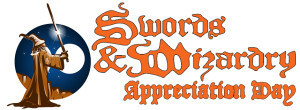 To celebrate the official Swords & Wizardry Appreciation Day April 17th I thought I’d share some combat rules I’ve been experimenting with, intended for use with the Swords & Wizardry based game Crypts & Things. If you’re new to the site, welcome. If you’re a regular visitor who’s not a gamer, be warned — your eyes are likely to glaze over if you try to read further.
To celebrate the official Swords & Wizardry Appreciation Day April 17th I thought I’d share some combat rules I’ve been experimenting with, intended for use with the Swords & Wizardry based game Crypts & Things. If you’re new to the site, welcome. If you’re a regular visitor who’s not a gamer, be warned — your eyes are likely to glaze over if you try to read further.
If you’re a regular visitor who games I hope you’ll follow the link I’ll post Friday to check out essays about Swords & Wizardry, not to mention some sales and giveaway contests.
Heroic Dueling
These rules are designed for those climatic moments when the hero faces off against the big bad – so long as that villain is more or less human sized and wielding weapons.
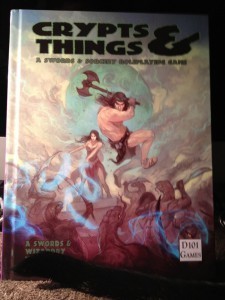 Over the years I’ve grown more and more disappointed about how these moments play out in various old school renaissance games because they often turn into boring back and forth rolls against armor class while the characters wear down one another’s hit points. I’m equally bored by more complex modern games and their elaborate feat trees, which still don’t get me what I’m after. I want an actual exchange of blows, dodges, shield blocks and clever tactics. Inspired by some of the rules I found in Crypts & Things and from good old Chainmail, I decided to experiment with some systems to make these combats more vivid.
Over the years I’ve grown more and more disappointed about how these moments play out in various old school renaissance games because they often turn into boring back and forth rolls against armor class while the characters wear down one another’s hit points. I’m equally bored by more complex modern games and their elaborate feat trees, which still don’t get me what I’m after. I want an actual exchange of blows, dodges, shield blocks and clever tactics. Inspired by some of the rules I found in Crypts & Things and from good old Chainmail, I decided to experiment with some systems to make these combats more vivid.
I hope it goes without saying that if you don’t like the idea of these rules, or a mini-game inside combat, I understand. I don’t mean to suggest that “you’re playing it wrong.” This rule set makes me a little happier and I’m offering a rough draft to any interested parties on the chance that some of you might enjoy it as well.
The rules are intended for use in mid to high-level OSR games, for fighters. And they really are intended only for those one on one (or two on one) combat scenes. To use them in every instance of combat would make combat monotonous and overly detailed, and if you’ve a party of more than three or four characters everyone would be bored watching this stuff play out if it happened every time
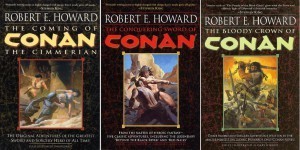 I’ve just gotten the rules working with one on one battles using swords, or swords and shields. I’ve yet to really experiment with dual swords or multiple opponents. If there’s interest I’ll keep developing. Of course I’m open to feedback. I’ve received some excellent suggestions from Kevin Crawford of Sine Nomine that might help streamline the process further, but I haven’t had time to play test them, so I’m sharing what I have.
I’ve just gotten the rules working with one on one battles using swords, or swords and shields. I’ve yet to really experiment with dual swords or multiple opponents. If there’s interest I’ll keep developing. Of course I’m open to feedback. I’ve received some excellent suggestions from Kevin Crawford of Sine Nomine that might help streamline the process further, but I haven’t had time to play test them, so I’m sharing what I have.
I built the rules over some existing Swords & Wizardry numbers, but I’ve changed some rules from regular combat as well, as you’ll see. If you’re using Weapons Mastery and Weapons Grand Mastery rules from Crypts & Things and your fighter routinely fights with sword and shield, assume for the ease of play that the chance to hit with both sword and shield is the same number because you practice with both all the time.
After the rules I’ve got an example of play to show them in action.
The Basic Rules
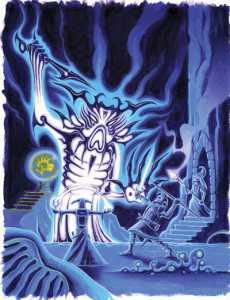
Artwork by Erol Otus.
The usual number of attacks per round rules DO NOT APPLY. They are replaced by Combat Points. No matter what level your fighter is, your attacks per round are determined by Combat Points.
Combatants alternate spending Combat Points to maneuver or Attack.
Every 5 second round, both attacker and defender get:
All their Combat Points (explained below).
1 free Strike OR Parry.
Combatant armed with a shield get 1 free Shield Block
Combatant armed with a parrying dagger get 1 free Parry and a +2 to Bind attempts. (Some swords and weapons, obviously, can’t be affected by a parrying dagger.)
Initiative
Roll initiative on D6. The combatants can spend up to 3 Combat Points to push initiative in their favor, including any (up to 3 total) they had left over at the end of the last round.
There are no Dex bonuses to initiative unless the combatant has 18 (+1) or the monster/opponent is lightning-fast, in which case the GM assigns an initiative bonus ranging from +1 to +3. (+2 or +3 should be reserved for some incredibly swift foe! +1 is bad enough.)
A result of the same initiative number from both sides means combatants move at the same time: if both combatants Attack without trying to Shield Block or Parry, they both may hit!
The combatant who wins initiative has momentum and drives the action until he or she misses, get Sidestepped, Blocked, Riposted, or runs out of Combat Points.
If a combatant chooses to take their first maneuver to Recover, the other combatant steals initiative.
Attacking
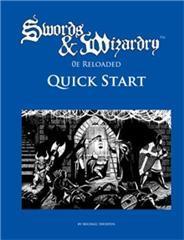 Regular to-hit and armor class numbers are used, even though they’re meant as an aid for the more abstract version of combat. (I wanted to avoid creating another OSR statistic.) As shields are actually used in this system, I advise against adding them into Armor Class calculations – although if you’ve added them in, removing them may require enough hassle that you won’t want to bother.
Regular to-hit and armor class numbers are used, even though they’re meant as an aid for the more abstract version of combat. (I wanted to avoid creating another OSR statistic.) As shields are actually used in this system, I advise against adding them into Armor Class calculations – although if you’ve added them in, removing them may require enough hassle that you won’t want to bother.
Once a combatant rolls a successful Attack it may not necessarily be a hit – it’s just a really strong blow. The defender, so long as he or she has a free Shield Block or Parry, or Combat Points remaining to spend on Block, Parry, Sidestep, or other maneuver, may be able to avoid any blow that’s not a critical. A defender out of all of those things takes the damage as usual.
When it’s a combatant’s turn to maneuver and he or she is on the attack, Offensive Maneuver Actions can stack with Attacks so long as the requisite Combat Points are available – Knocking and Attacking, Distracting and Attacking, Attacking and Lunging, Feinting and Attacking, etc. Note that some of those Maneuver are one roll (Attacking and Lunging and Feinting and Attacking) and some are two, like Distracting and Attacking and Knocking and Attacking, depending in some part upon how the GM and player envision the actions.
Criticals occur on a natural 20. Criticals don’t do extra damage; they mean the coming blow cannot be Parried, Sidestepped, or Blocked, and they bypass armor.
Fumbles must be confirmed (a 1, then another 1). Characters from sword-and-sorcery novels, and their opponents, just don’t fumble very often, if ever. Usually, then, a 1 is a simple miss.
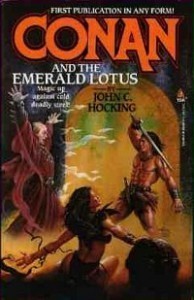 Defending
DefendingA combatant Blocking or Knocking with a shield can immediately continue with an Attack so long as they have a free Attack or Combat Points remaining that allow it.
A defender who Parries has used his or her action and then it is the other combatant’s turn once more UNLESS the defender has enough Combat Points to stack a maneuver with the Parry. A combatant parrying with a sword must spend points to Riposte, Bind, Sidestep, or Disarm to steal initiative and Attack – if they’re trying to defend. If they just want to take the damage and NOT parry, they can, which would also leave the defender free to respond so long as he or she is still alive!
A defender can stack Maneuver Actions: Retreat and Avoid, say, or he or she can take the offensive with a successful Shield Block or Knock plus Attack. Or, if the combatant is shieldless, instead of trying to Parry, he or she could Sidestep.
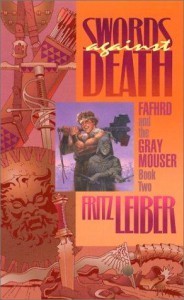 Damage
DamageDamage is taken straight to Constitution. Taking it to Hit Points would prolong dueling to the point of monotony. To keep things simple, armor protects per the bonus it usually gives to armor class, so, for instance, ring mail absorbs 3 points of damage. Shields don’t absorb damage in this system since they’re used directly to block.
A hit location table could be used if you want to get more complicated.
Using armor twice – to calculate the armor class as well as to protect — may seem like double-dipping, but, again, recalculating to-hit numbers every time there’s a duel is just asking too much. This is supposed to be a fun alternate system, not a new way to increase book keeping. Humans taking damage straight to Con really should be able to have armor absorb some of the damage or they’ll go down fast against fell beasts of chaos and blood-thirsty bandit chieftains.
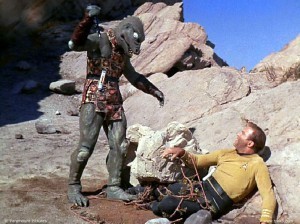 Calculating Opponent Con Scores
Calculating Opponent Con ScoresMonsters and many adversaries don’t routinely have Constitution scores, so here’s a quick way to wing it. They get one point for each Hit Die, and then determine the rest by size and toughness. Smallish (8); Human sized (12) Larger (16). If they’re especially strong or robust add in another 2-4 points, keeping in mind that their Constitution points shouldn’t be too much higher than a hero’s. This system isn’t about beating away points until they’re gone, but about out maneuvering and out fighting.
If the opponent has a tough hide, assign them 1-3 extra armor points, remembering that even a little is a lot in this mini-system, and if they wear armor, apply as discussed, previously, with the AC bonus equaling the protection value of the armor.
So, for example, suppose we have a 5HD Fell Beast of Chaos. It’s got the head of a deer with empty eye sockets that burn with silver flame, but it’s human sized, so it’s a 12. It’s not any more robust than a normal human, and it doesn’t have a tough hide, so its Constitution points are 12+5 or 17.
It’s legs are clothed in stinking black furs and its chest is bare, so there’s no need to calculate armor.
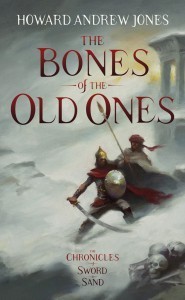 Combat Maneuvers
Combat ManeuversCombat Maneuvers are activated by the expenditure of Combat Points, which reset at the end of every round (which are of 5 second duration). As soon as a round is over, assuming that the combatant lives, the points reset. Combat Points unused at the end of a round can be spent to add a bonus to the initiative roll of the coming round (well, up to 3 of them). They can NOT be stockpiled to use the next round EXCEPT to help with initiative.
Combatants receive 1 Combat Point per hit die up until level 10. Afterward, they get one Combat Point per five levels. So every round an 8th level fighter armed with a sword and shield gets one free Strike (or Parry), one free Shield Block, and 8 Combat Points. A fell beast of chaos with 5HD armed with a sword and shield gets one free Strike (or Parry), one free Shield Block, and 5 Combat Points every round. A 20th level Fighter armed with a sword would get one free Strike (or Parry) and 12 Combat Points every round.
To use a Combat Maneuver is as simple as rolling the regular to-hit die against the opponent’s armor class, using the indicated modifiers in the Description column of the Defense or Attack Maneuver charts. A success indicates that the maneuver may have been effective, although the opponent can try to counter.
To defend against a Combat Maneuver usually requires expenditure of a Combat Point (unless the combatant is using the round’s free Shield Block, or Parry). After spending that Combat Point(s), the defender must then roll higher than the attacker with his or her own to-hit roll, applying modifiers as indicated in the Description column of the Attack Maneuvers Chart or Defense Maneuvers Chart, for example, adding in a defense bonus for variously sized shields. (Not equal to, but higher.) A success means that the attacker’s action failed. In some instances (Avoiding a Feint or Bind) the initiative may well switch to the defender, although the GM should be final arbiter.
Some Maneuvers require a slightly different mechanic, explained in the description.
Pardon the terrible chart formatting — I couldn’t figure out how to make the danged tables work in WordPress.
Attack Maneuver Chart
Combat Maneuver…..Point Cost………………Description
Attack……………………….. 5……………………….Additional attack after the free one.
Bind……………………………1……………………….Locks up enemy weapon so they can’t strike without expending Recover point. Successful Bind gives a +2 to Disarm.
Disarm………………………..4……………………….-4 to roll. Bonuses stack with this maneuver, so if opponent is distracted and their sword is Bound, then attacker gets +4.
Distract……………………….2………………………..Success means that defender is at -2 for rest of round, or, if Distract comes at end of the round, until they spend a Combat Point to Recover.
Feint……………………………1………………………..Opponent must roll higher to detect. Success means opponent can’t Shield Block or Parry incoming Attack!
Knock…………………………..2……………………….Successful Knock slams shield (or sword) into blade to knock it aside (or moves it out of the way with parrying dagger, cloak, etc.). Success gives +2 to hit on Attack if it immediately follows, even if it is the next round. Those effected by Knock must Recover.
Lunge…………………………..3 + Attack………….. Stacked with regular Attack and doubles damage before bonus. Reduces attacker combatant’s AC to 10 during opponent combatant’s next action and any maneuver tried before spending a Combat Point to Recover occurs at a -2.
Maneuver Opponent……..3……………………….Advance with flurry of blows to force opponent to expose flank to ally, to move them closer to an edge, etc. Success does not inflict damage.
Minor Attack………………..2……………………….Roll as regular Attack, 1-4 damage. Kick, punch, strike with pommel, shield bash, etc. Alternatively, the minor attack impedes balance with a trip or something similar, providing a +2 to the attacker’s next Attack until defender can spend a Combat Point to Recover.
Riposte………………………..1 (+ Attack)………..Combatant steals initiative and, so long as he or she still has their free Attack or Combat Points to make a new one, they can take the offensive. Note that Wait gives a free Riposte if combatant has successfully parried.
Defense Maneuver Chart
Combat Maneuver……Point Cost……………….Description
Avoid…………………………..1………………………..A success negates Bind and Knock attempts and detects a Feint.
Parry……………………………1……………………….Success grants a +1 to an immediate Disarm attempt. (A critical success enables a free Riposte.)
Recover………………………..1………………………..Combatant recovers equilibrium, backs up, adjusts stance, etc. so as to suffer no minuses. Can stack with Retreat.
Retreat…………………………2……………………….A fighting retreat, so long as the defender has room. Enemy combatant attacks at -2 until enemy combatant uses Recover – which in this case means they close the distance. Note that if combatant who’s retreating wants to reverse and Attack, he or she must spend a point to Recover as well, not to mention points for Attack.
Shield Block………………….1……………………….Raising shield to block an attack, adding in a bonus to their roll of +2 for little shield, +4 for med shield, +6 for large shield. Success blocks attack.
Sidestep………………………..2……………………….A skilled warrior can simply try to step aside to avoid the attack. 18 Dex add +1 to attempt. Failure incurs +2 damage.
Wait……………………………..1………………………..Watch other opponent, get +2 on next roll (Parry etc.). Two opponents waiting cancel each other’s bonus out – somebody has to act! A successful Wait gets a free Riposte.
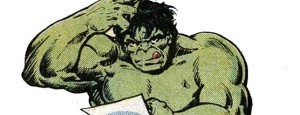 Additional Clarifications
Additional ClarificationsCombat Point effects are usually over at the end of the round, excepting the following, if they occur as the last action of the round:
A Wait gives the combatant a +2 to initiative rather than the +2 to the next roll as per usual.
A successful Distraction as the last action of the round gives the effected combatant a -2 on all rolls throughout the coming round, until they spend a Combat Point to Recover, including initiative.
A successful Knock carries over into the next round until the affected combatant spends a point to Recover.
A Retreat means the distance has been opened up. An attacker or defender can close the distance by spending a Recover point (in this instance Recover means it would be closing the distance — why bother creating another category and complicating things further?)
Example of Play
Koll, Slayer of Beasts, and his friend Kalina have just defeated the undead minions of Andrath the wizard. The wizard has fled through a curtain. As Koll races forward, the fabric parts and out steps a man-high beast with a deer’s head holding a black shield and a sword with a curved tip. Where its eyes should be are silvery flames matched by the eerie fire racing along the edge of its blade.
GM: The fell beast brandishes its sword, laughing in a high, warbling voice. “Die, man-thing!”
Koll: The beast is mine!
Koll is 8th level, which means he has 8 Combat Points. His Armor Class is 16 and he needs a 9 to hit the Fell Beast. His Constitution is 16. Constitution rather than Hit Points is used for heroic duels, as explained above — along with how to calculate Constitution scores for creatures that don’t normally have them listed. His sword does 1d8 +1, +2 damage due to Koll’s strength, for a total of +3.
The Fell Beast has 5 HD, which means it has 5 Combat Points. It has an AC of 16 and needs an 11 to hit Koll. It has 17 Constitution points (explained above). It’s sword does 1d8+2 — it gets an extra point for its unholy flame.
Both combatants are armed with sword and shield, mostly so you can see how much of an advantage a fighter armed with a shield and sword would have over someone just carrying a sword. It’s a lot easier to fend off blows!
Round 1
The GM and Koll’s player roll initiative. Neither the Fell Beast nor Koll has a Dex or speed bonus and neither spend Combat Points to improve initiative, so there are no modifiers to either roll. The Fell Beast rolls a 3 and Koll gets a 2 — the beast wins initiative and swings its flickering sword expertly — a 19, with modifiers.
GM: It’s a solid blow!
Koll: I bring up my shield. (This is his free Shield Block for the round. He rolls a 12. With his modifiers to hit, including the +4 for using a medium shield, he just barely takes the blow by rolling higher than the attack.)
GM: The sword clangs dully off your shield.
Because you can stack Shield Block with Attack, this is exactly what Koll does.
Koll: I glower and swing for his vitals. (With modifiers he gets a 20.)
GM: A mighty blow! The beast tries to bring its own shield in line… (and with a 14, plus 4 for his shield, plus 5 for its hit die, the beast easily takes the blow and rolls higher than Koll). Your sword dents its shield.
The beast has now used both its free Attack and its free Shield Block for the round. As it’s an evil thing eager for the blood of men, the GM decides the beast is simply going to Attack, so it uses its 5 Combat Points for a second swing. This will drain all of its Combat Points and leave it wide open for anything Koll counters with, but then it’s a Fell Beast of Chaos, so it probably doesn’t plan ahead too well.
GM: (Rolls a 6+5) 11! It swings wildly but it looks like another solid blow.
Koll: I take it on my shield. (He spends 1 of his 8 Combat Points, rolling a 7, +4 for the shield, +4 for his other modifiers easily getting higher than the Fell Beast’s Attack). And I immediately counter! (Koll swings a second time, spending 5 more Combat Points. Unfortunately, he rolls a 2. Even with modifiers that’s a miss.)
GM: The beast capers madly and twists away from your sword point.
Koll: I slam my shield into his sword.
This uses Koll’s 2 Combat Points for the round for the Knock. Koll rolls a 9, which is a hit even without modifiers. The beast has no Combat Points to try to Avoid or Sidestep.
GM: You knock its blade arm out of the way! It’s wide open!
Round 2
Unfortunately for Koll, the Fell Beast rolls a 6 for initiative and he only rolls a 3, which means Koll’s unable to follow up on his successful Knock to get his +2 to hit. On the other hand, the Fell Beast has to spend a Combat Point to Recover to get its sword in line before it can act, and that means it only has 4 Combat Points remaining, which won’t give it enough for a second Attack this round — they cost 5 Combat Points. And since it has to Recover, that means the first move goes to Koll. Here’s where we begin to see how much of a difference judicious play and a surplus of Combat Points make.
GM: The beast hisses at you and backsteps, bringing its sword in line.
Koll: I charge it, knocking the sword aside with my shield once more and swinging straight for its throat!
The GM asks if this is a called shot and Koll’s player confirms he’s just using descriptive color, which is good, because the GM doesn’t have called shot rules yet — although maybe a -2 would suffice. Koll is stacking his Knock with an Attack, which is permissible in the rules, and expends only 1 Combat Point while doing it because every combatant gets one free Attack each round. He rolls a 9 +4 with the shield for a total of 13 (that’s a +4 because of Koll’s to-hit bonus — you don’t add in the shield’s defense bonus to attacks). The Fell Beast spends another of its dwindling Combat Points to try to Avoid, which means it tries to roll higher to get its sword out of the way of the Knock. It rolls an 18 before modifiers. A success!
GM: The beast lifts its sword out of the way of your shield.
Koll still finishes the second part of his stacked Maneuver, the actual sword blow, which is free, as it’s his free Attack for the round. He rolls a 12, for a total of 16.
GM: The beast desperately raises its shield… and blocks your attack!
The GM has rolled a natural 20. Maybe there should be rules for shattering shields and swords, but I’m not there yet. In any case, Koll’s attack fails. The beast has used its free Shield Block for the round. Now it uses its free Attack and stacks it with a Lunge. This is probably a foolish move, unless it connects. It will spend the last 3 of its remaining Combat Points.
GM: Laughing at you, the beast lunges, trying to slip past your guard. (The GM rolls a 17 +5 for a 22.)
Koll: I plant my feet and throw up my shield.
This is Koll’s free Shield Block for the round. He rolls a 3! Even with a 4 to-hit bonus and a 4 for the medium shield it’s not enough! The Fell Beast slides past the shield and strikes him for double damage. The GM rolls a 5. Doubled, that’s a 10, and with the bonus added in that’s 12. 3 of that is absorbed by Koll’s ring mail, so Koll’s taken a puncture wound and some bruising. It’s the middle of the combat, though, and he has so much adrenaline running through him Koll barely notices the wound.
Koll: I roar in pain and fury and slash at the beast!
Here’s where we see the problem with a lunge when your opponent is still at decent strength and has Combat Points remaining. Because of its lunge, the Fell Beast’s AC has been reduced to 10 before we figure in Koll’s chances to connect, which means it’s nearly impossible for Koll to miss. Koll rolls an 18! With his modifiers, that means a 22.
GM: The beast sees the blade descending toward its shoulder and can do nothing to counter. (It used its last Combat Point).
Koll: I laugh! (He does 8 points of damage to the beast.)
GM: You open up a deep slash across its shoulder and upper chest, which burns with silver flame.
Koll: You burn prettily! (He’s quoting Corwin of Amber, so the GM smirks. )
Koll has 2 Combat Points remaining and elects to add them to his initiative roll at the beginning of the next round.
Round 3
Koll and the Fell Beast both roll a 4 for initiative, but Koll has the +2 because of his Combat Points from last round and wins with a 6.
Koll: I feint for the burning wound then swing for its neck.
Koll spends the first Combat Point of the round and rolls once for his Attack. He gets a 10 for the Feint/Attack, a total of 14. The Fell beast spends its first Combat Point to try to “Avoid” — meaning notice in this instance — the effect of the Attack and tries to roll higher. It gets a 9, which is just too perfect for this example. 9+5 (for its 5 hit dice) is a total of 14 — which is NOT higher than 14, which means that Koll’s Feint+Attack succeeds and Koll now rolls for damage. The Fell Beast has been tricked and can neither Parry nor Shield Block. Koll rolls a 7 for damage, and with his bonus that’s more than enough to finish the beast. As is typical for this game group, the GM informs the player that he’s slain the creature with ample room, leaving the player to describe the result.
Koll: It raises its sword to protect its shoulder, but I come in from the other side and cleave completely through its neck! The head is sliced free and thunks against the floor!
GM: The body crumples. The shield and sword clang to the flagstones and the silver flame burning along the beast’s wounds spread quickly over its body. The head continues to laugh madly as it’s consumed in fire.
Additional Thoughts
The Combat Points should go a long way toward simulating more cinematic fight scenes during important points in the narrative. I think that this system demonstrates how useful shields truly are, an idea that never comes across in standard combat simulations. I also like that some of the complexities of fencing maneuvers are suggested without going into excruciating detail or using feats.
There should probably be a combat track on the bottom of a character sheet…
I suppose I need some shield rush rules in here… and that I could spend some more time on two handed fighting. So far I’ve mostly been testing more standard fighting styles with sword, or sword and shield.
There are downsides to carrying around large shields that probably don’t show up in this particular rule set. It’s intended to simulate play with sword-and-sorcery or swashbuckling style characters, though, who don’t usually cart around huge shields. And I suppose there may be some benefit to speed in carrying a little shield or going shieldless, but how technical can this get and still remain fun?
I wonder if the armor provides enough protection… I might want to raise the protection values.
The dueling system might conceivably work against equivalent sized foes who aren’t humanoid– like, say panthers – but I haven’t experimented with that yet. Obviously the creature or monster wouldn’t be able to Parry or Shield Block, but a panther or giant snake character could try moves like Sidestep and Feint.
These two-handed fighting rules are designed around sword and shield and fencing dagger and rapier a la actual swashbucklers. I haven’t tried out the whole “I’m armed with two swords of equal length” thing yet, as it’s more of a fantasy trope that rarely existed in the real world. Real sword fighters seem to find that more trouble than it’s worth, but I suppose I need to work that out anyway.
Enjoy!
Howard Andrew Jones
April 15, 2015
Mind Meld and Memories
 I’m over at SFSignal today with a number of authors, Mind Melding about cities in science fiction and fantasy, and epic road trips. You can probably predict that I mentioned Amber, Lankhmar, and Baghdad.
I’m over at SFSignal today with a number of authors, Mind Melding about cities in science fiction and fantasy, and epic road trips. You can probably predict that I mentioned Amber, Lankhmar, and Baghdad.
On a more somber note, I’ve been mourning a childhood friend, dead now for 18 years. We hadn’t stayed in touch very well after high school, but I’m certain we would have reconnected in the years following. God alone knows exactly what artistic career he would have ended up choosing with his in-born talent and drive, but I’m certain he would have prospered. I like to think Jon and I would have joined forces and worked together on some projects.
These days I’m sad to say I usually don’t think about him as often as I used to. Time dulls wounds, even that of the passing of an old friend, and you get swept up into the present and caring for and thinking about the living. It’s even been a few years since I’ve dreamed of him. Maybe you’ve had similar ones when someone you love is gone. You discover they’re actually still alive, just in the wrong place, or that they survived but are changed or permanently injured.
That said, I’ve been thinking about him more and more the last months. My son, born with the same kind of artistic talent and drive, is heading off to college soon to study art. I’d give a lot for Jon to have been able to sit down with my boy and talk to him about the field and all he’d learned.
But then I’d give even more if Jon could simply be here to visit with his parents and his sister. Were he alive today I imagine we’d ping each other on Facebook every few weeks even if we weren’t in regular touch. Probably we’d call each other a few times each year and talk about our jobs and families and laugh and encourage each other with whatever crazy thing we were working on.
Here’s to you, old friend, and walks in the woods dreaming of our future, and games of Dungeons & Dragons with Sean. Here’s to reading Warlord and X-Men comics and Elric and Amber and beating the hell out of each other with stuffed tube socks and garbage lids, pretending we were knights fighting with flail and shield.
Your mom told me that she’d found my Kansas phone number in a pile of papers on your desk, and that she thought you were planning to call me. I wish you had. God, how I wish I’d called you.
April 13, 2015
Good Conduct… and Confusion
 Mary Robinette Kowal, in her intelligent, well-mannered way, has launched the most even-handed discussion of the recent Hugo debacle that I’ve yet read. Admittedly, I haven’t scoured the web to read EVERY essay or report about the current mess, but I’ve remained up to date. You can find Mary’s essay here, and the remarks in the comments section are worth reading as well, for most of the contributors from both sides of the debate remain respectful.
Mary Robinette Kowal, in her intelligent, well-mannered way, has launched the most even-handed discussion of the recent Hugo debacle that I’ve yet read. Admittedly, I haven’t scoured the web to read EVERY essay or report about the current mess, but I’ve remained up to date. You can find Mary’s essay here, and the remarks in the comments section are worth reading as well, for most of the contributors from both sides of the debate remain respectful.
I use the term “both sides” loosely, because there’s not truly an either/or divide, as much as some would like to believe, or would like others to believe. I appreciate that Mary recognizes this.
 I think John O’Neill, over at Black Gate, has also dealt with the Hugo conflict well. Honestly, I think it’s a crime that O’Neill’s been doing yeoman’s work with Black Gate for more than a decade (before I joined and after my departure) and that he has never gotten on the nominating ballot until now. That has long suggested to me that there IS bias at work within the Hugo nominations, although I’m not ready to say that there’s a cabal. I object to voting blocs of any kind, and there are accusations from some of the people who put their various puppy blocs together that “the other guys did it, so I’m doing it too” which doesn’t win points with me. It doesn’t mean I like the thought that the other guys did it, though.
I think John O’Neill, over at Black Gate, has also dealt with the Hugo conflict well. Honestly, I think it’s a crime that O’Neill’s been doing yeoman’s work with Black Gate for more than a decade (before I joined and after my departure) and that he has never gotten on the nominating ballot until now. That has long suggested to me that there IS bias at work within the Hugo nominations, although I’m not ready to say that there’s a cabal. I object to voting blocs of any kind, and there are accusations from some of the people who put their various puppy blocs together that “the other guys did it, so I’m doing it too” which doesn’t win points with me. It doesn’t mean I like the thought that the other guys did it, though.
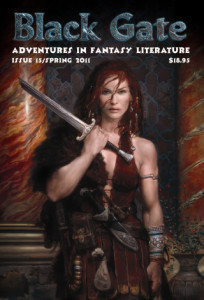 I think some of the reason the nominations float the way they do doesn’t have as much to do with blocs or cabals as taste. I noticed years before that magazines didn’t seem especially attracted to adventure anymore and that they preferred character centered or literary fiction for the most part, which has never interested me very much. It seems like just yesterday, but I realize now it’s been nearly fifteen years, when I was writing short adventure stories and looking for places to put them and finding very few. I wasn’t alone. These days sword-and-sorcery and heroic fiction is a lot more popular, albeit a little more grim, and is easier to find, but I think that the movers and shakers are still frequently more interested in message than story. You can probably cite some examples where I’m wrong, and that’s great, but I think those are more the exception than the norm.
I think some of the reason the nominations float the way they do doesn’t have as much to do with blocs or cabals as taste. I noticed years before that magazines didn’t seem especially attracted to adventure anymore and that they preferred character centered or literary fiction for the most part, which has never interested me very much. It seems like just yesterday, but I realize now it’s been nearly fifteen years, when I was writing short adventure stories and looking for places to put them and finding very few. I wasn’t alone. These days sword-and-sorcery and heroic fiction is a lot more popular, albeit a little more grim, and is easier to find, but I think that the movers and shakers are still frequently more interested in message than story. You can probably cite some examples where I’m wrong, and that’s great, but I think those are more the exception than the norm.
I certainly don’t feel that the white man has been under represented, but I have sympathy for the notion that there’s not enough adventure in a lot of what comes up for the vote. That said, for years tastes swung a different direction, and I expect the needle will shift around every generation or so. Not TOO long ago the stuff that’s popular now couldn’t get a seat at the table.
 Me, I’ve always liked my message fiction to have a good story to go with it. Consider, for instance, the original Star Trek episode “The Devil in the Dark,” which is a cracking good alien monster hunt story that also addresses prejudice. Then compare it to the later Star Trek episode with the half-white/half-black guys who hate each other because one’s black and white on one side and the other’s white and black on the other. They both have messages, but one is a helluva lot more subtle and tells a much better tale. Still, some people like the one more than the other, and like it better, and I guess it comes to taste. That’s not to say all message or experimental fiction is only as good as a schlocky tv episode of a pulpy TV show, just that some message fiction seems to BEAT YOU over the head with the point and forget the story and get praises anyway.
Me, I’ve always liked my message fiction to have a good story to go with it. Consider, for instance, the original Star Trek episode “The Devil in the Dark,” which is a cracking good alien monster hunt story that also addresses prejudice. Then compare it to the later Star Trek episode with the half-white/half-black guys who hate each other because one’s black and white on one side and the other’s white and black on the other. They both have messages, but one is a helluva lot more subtle and tells a much better tale. Still, some people like the one more than the other, and like it better, and I guess it comes to taste. That’s not to say all message or experimental fiction is only as good as a schlocky tv episode of a pulpy TV show, just that some message fiction seems to BEAT YOU over the head with the point and forget the story and get praises anyway.
I digress. I am super pleased that Black Gate is on the ballot, and irritated that it will probably get swept away under a tide of No Awards because of how it got there and I’m further irritated that it took so long for the establishment to notice how hard John’s worked, thanklessly, for so many years… except, wait, the establishment DID NOT recognize O’Neill — he only got on through this bloc vote thing, which I really don’t like. Sigh.
If I were to receive a Hugo (as if!) as the result of a voting bloc, I’d feel compelled to return it, and I think that’s what Matthew David Surridge was saying. On the other hand, John O’Neill and his staff deserve attention and acknowledgment, and they deserve the nomination, so I’m left feeling confused. (Keep in mind I’m busy enough with my own stuff that I’m only tangentially connected to BG anymore, so I’m not patting my own back.)
Rather than forming an opinion and wandering online to discuss it I think I’m just going to stay muddled, shrug my shoulders, and get back to work. If you want to talk about it here, feel free, but keep it civil. Remember the rules.
April 10, 2015
Swords Against Death Re-Read: “The Bleak Shore”
 Bill Ward and I are re-reading a book from Fritz Leiber’s famous Lankhmar series, Swords Against Death. We hope you’ll pick up a copy and join us. This week we tackled the fourth tale in the volume, “The Bleak Shore.”
Bill Ward and I are re-reading a book from Fritz Leiber’s famous Lankhmar series, Swords Against Death. We hope you’ll pick up a copy and join us. This week we tackled the fourth tale in the volume, “The Bleak Shore.”
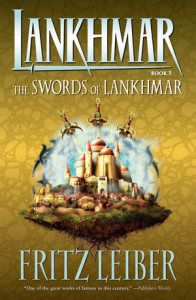 Howard: “The Bleak Shore” felt a little like a story written on deadline. That’s not to say that there aren’t any masterful moments. In lesser hands the emergence of the things from the eggs would have seemed a lot less tense and perhaps even ridiculous, whereas Leiber pulled off horror. Then there are wondrous visual descriptions of the sea travel and of the behavior of the characters under the curse.
Howard: “The Bleak Shore” felt a little like a story written on deadline. That’s not to say that there aren’t any masterful moments. In lesser hands the emergence of the things from the eggs would have seemed a lot less tense and perhaps even ridiculous, whereas Leiber pulled off horror. Then there are wondrous visual descriptions of the sea travel and of the behavior of the characters under the curse.
Bill: I can’t disagree. I think the climax may have been a bit hastily written as well. One interesting thing about the story is the switch to the last surviving Mingol crewman for the narration of the “geased” voyage, and then a switch back to our heroes in media res on the Bleak Shore far from civilization. A great way to both economize and build tension, and also to create that great sort of ‘doomed expedition’ weird tale vibe.
 Howard: A good point. I thought Ourph’s narration of the ill-fated sea voyage really evocative — my only problem with it was that I signed on for the adventures of Fafhrd and Mouser, not the sea voyage of Ourph the Mingol. But that’s a minor quibble. More troubling — it wasn’t entirely clear to me what the Mouser had done at the very end. Is that the sorcerer he’s killed, and the guy they saw in the tavern was a simulacrum? Or is this some kind of entity linked to the sorcerer? And then I have to say I was disappointed that I saw so little of the banter and camaraderie that I’d enjoyed so much in the last two stories. During most of this one Fafhrd and the Mouser are cursed and driven. And while Leiber did a great job showing us what that was like, I missed them as usual.
Howard: A good point. I thought Ourph’s narration of the ill-fated sea voyage really evocative — my only problem with it was that I signed on for the adventures of Fafhrd and Mouser, not the sea voyage of Ourph the Mingol. But that’s a minor quibble. More troubling — it wasn’t entirely clear to me what the Mouser had done at the very end. Is that the sorcerer he’s killed, and the guy they saw in the tavern was a simulacrum? Or is this some kind of entity linked to the sorcerer? And then I have to say I was disappointed that I saw so little of the banter and camaraderie that I’d enjoyed so much in the last two stories. During most of this one Fafhrd and the Mouser are cursed and driven. And while Leiber did a great job showing us what that was like, I missed them as usual.
Perhaps I should be pleased that he managed variety so that a Fafhrd and Mouser tale isn’t just the same thing every time… but there really aren’t THAT many of these written at the height of his powers, so I still felt a little let down.
Bill: There is one line about the wizard “sending the spirit of himself out into the world,” or something. My guess is that the embryonic wizard grows in the egg until some adventurers arrive to meet their death (and provide him with energy?), then he hatches and goes out into the world to send more adventurers back to the bleak shore, where the process would repeat.
 Howard: Yeah, you may be right. That feels a lot weaker than what we saw last week, as though it were made up on the fly. I don’t think this was a bad one (certainly I’ve re-read it more than once, which is more than I can say for the tales in Swords and Ice Magic). It entertained me, and there were moments of excellence, but it’s certainly not one that will make my best-of list.
Howard: Yeah, you may be right. That feels a lot weaker than what we saw last week, as though it were made up on the fly. I don’t think this was a bad one (certainly I’ve re-read it more than once, which is more than I can say for the tales in Swords and Ice Magic). It entertained me, and there were moments of excellence, but it’s certainly not one that will make my best-of list.
Bill: Agreed. There’s not a whole lot to add to this one. It was a short, fun story with some great invention and the always wonderful writing of Leiber, but not a standout.
Howard: That’s it, then. Next week we’ll move onto one I remember being a lot stronger, “The Howling Tower.”
April 3, 2015
Swords Against Death Re-Read: “Thieves’ House”
 Bill Ward and I are re-reading a book from Fritz Leiber’s famous Lankhmar series, Swords Against Death. We hope you’ll pick up a copy and join us. This week we tackled the third tale in the volume, “Thieves’ House.”
Bill Ward and I are re-reading a book from Fritz Leiber’s famous Lankhmar series, Swords Against Death. We hope you’ll pick up a copy and join us. This week we tackled the third tale in the volume, “Thieves’ House.”
Howard: I see now why I remembered this one so fondly. Consider the following ingredients: a twisting maze in a building so old that even its inhabitants don’t know all of its secrets: trap doors, secret passages, action, mayhem, a beautiful dancing girl, treasure, horror…
So far as I know, this is the first ever mention of a guild of thieves (remembering that the “earlier” story, “Ill Met in Lankhmar” was written decades after this one). A thief is referred to as being “a cutpurse of the first rank.” You combine that with the traps and treasure and the horrors and it’s pretty darned clear what a huge influence this story had to have had on original Dungeons & Dragons, not to mention all other fantasy games and all writers who grew up playing them.
 Bill: I noticed all that as well, and it had me wanting to roll to check for traps a few times.
Bill: I noticed all that as well, and it had me wanting to roll to check for traps a few times.
Howard: Hah! And how about the horror? Leiber hits it out of the park. In lesser hands we would just have seen some talking skeletons. Instead, we only ever glimpse them, or their actions. A character might brush against one, or hear the clack of them, or see a dead man’s neck with marks upon it that are strangely claw-like. Then there are the touches like the “old thieves” being able to see Fafhrd in pitch-black, or the flight of skeletal bats, or the jewel-like glimmer of eyes floating in the darkness… it’s just fabulous.
Bill: All that also struck me as particularly impressive. The scene where Fafhrd is being discussed by the ancient dead is especially creepy (as well as somewhat funny, a hard balance to strike), as is the teasing description of the emergence of the dead at the climactic part of the story. Not for nothing is Leiber also celebrated for his more horrific weird tales, such as “The Smoke Ghost,” and I was reminded again of his skill in this story.
Howard: Great point about the humor. Leiber manages to have a comforting thread of humor even as he’s chilling you with the supernatural.
 Another thing I loved is that all the principal characters are clever, and all of them have their own agendas. I love the Mouser’s last desperate plan to find the skull to save Fafrhd, dressed the while as an old woman. He’s so into the role he half believes it himself, because the Mouser is, like many actors, a little egocentric. I love how Fafhrd, truly in a desperate situation, plays upon the fears of his enemies and embellishes the tale of what happened to him to buy time. And then when the Mouser creeps in, he hears Fafhrd’s story — we can infer this through the Mouser’s actions — and performs that wonderful mummery with the floating skull and high disembodied voice that almost tricks the thieves.
Another thing I loved is that all the principal characters are clever, and all of them have their own agendas. I love the Mouser’s last desperate plan to find the skull to save Fafrhd, dressed the while as an old woman. He’s so into the role he half believes it himself, because the Mouser is, like many actors, a little egocentric. I love how Fafhrd, truly in a desperate situation, plays upon the fears of his enemies and embellishes the tale of what happened to him to buy time. And then when the Mouser creeps in, he hears Fafhrd’s story — we can infer this through the Mouser’s actions — and performs that wonderful mummery with the floating skull and high disembodied voice that almost tricks the thieves.
And how about Slevyas? What a clever and capable fellow. You can’t help but respect him. He’s much more agile than he looks and he’s an excellent commander. If he had simply been a little more open to the idea of the supernatural he might have survived.
Bill: And, in the case of F&GM, those are some great character moments as well. Fafhrd is a trained storyteller, and his barbarian poetic license really confuses some thieves that had never been on the receiving end of an epic before. And the Mouser in disguise is classic, a born actor whose most convincing flourish as a witch is producing a kitten from under his rags. These characters are fun, and you want to know even more about them every time Leiber gives us juicy bits like that.
 Howard: Absolutely. We get to know Ivlis only a little, but she has enough agency that she becomes more than a simple “prize to be won.” When she’s sitting at the table at the end with Fafrhd and the Mouser she has a voice of her own.
Howard: Absolutely. We get to know Ivlis only a little, but she has enough agency that she becomes more than a simple “prize to be won.” When she’s sitting at the table at the end with Fafrhd and the Mouser she has a voice of her own.
We could probably spend pages just going on about all the wonderful little touches like how Fafrhd gets lost, or how the Mouser kicks someone deserving while in disguise, or how its rumored the thieves have taken up worship of something in the cellars of Thieves’ House.
Honestly, I find it difficult to find much fault. The opening sequence might feel a little awkward because we don’t get any names and everyone has to be referred to by a string of descriptors (red-headed wench, fat thief, black-bearded thief). But as I went back again I saw Leiber was playing his game by certain rules. No one gets called by name in the prose until that name is used by a character in the text. Once they’re introduced by name, then we can get into their inner thoughts and the camera can close in on any one of them whenever Leiber wants and switch to their point of view. He’s so skilled at it that I may have to read it again just to watch for the switches.
Bill: I may read it again just to follow along with that technique. At some point I found I’d lost track of how the POVs were unfolding, and I just forgot about them and let myself get swept up in the action.
Howard: Right there with you. I’m looking forward to reading the next one, and I can just about guarantee I’ll revisit “Thieves’ House” again soon.
Howard Andrew Jones's Blog
- Howard Andrew Jones's profile
- 368 followers



